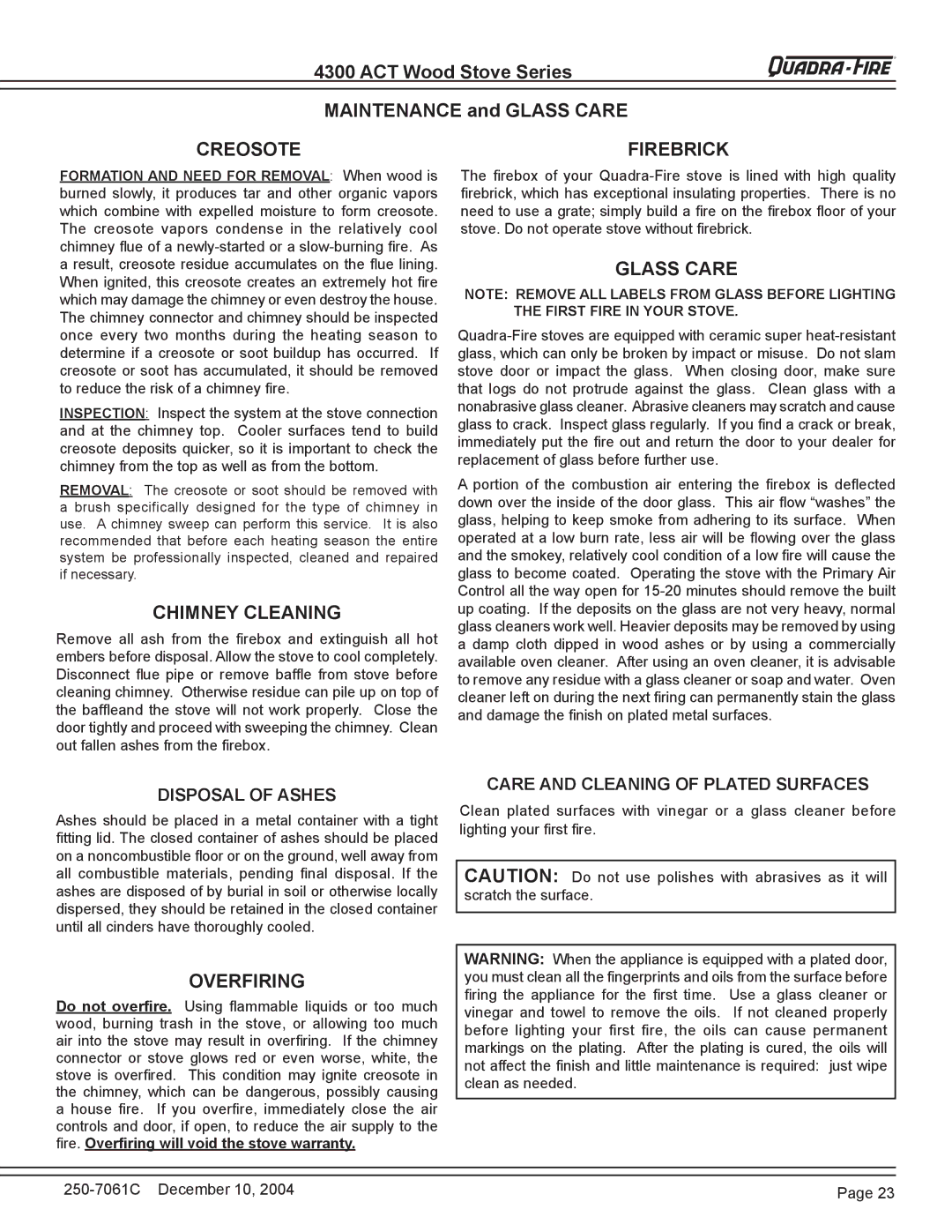
R
4300 ACT Wood Stove Series
MAINTENANCE and GLASS CARE
CREOSOTE
FORMATION AND NEED FOR REMOVAL: When wood is burned slowly, it produces tar and other organic vapors which combine with expelled moisture to form creosote. The creosote vapors condense in the relatively cool chimney flue of a
INSPECTION: Inspect the system at the stove connection and at the chimney top. Cooler surfaces tend to build creosote deposits quicker, so it is important to check the chimney from the top as well as from the bottom.
REMOVAL: The creosote or soot should be removed with a brush specifically designed for the type of chimney in use. A chimney sweep can perform this service. It is also recommended that before each heating season the entire system be professionally inspected, cleaned and repaired if necessary.
CHIMNEY CLEANING
Remove all ash from the firebox and extinguish all hot embers before disposal. Allow the stove to cool completely. Disconnect flue pipe or remove baffle from stove before cleaning chimney. Otherwise residue can pile up on top of the baffleand the stove will not work properly. Close the door tightly and proceed with sweeping the chimney. Clean out fallen ashes from the firebox.
FIREBRICK
The firebox of your
GLASS CARE
NOTE: REMOVE ALL LABELS FROM GLASS BEFORE LIGHTING THE FIRST FIRE IN YOUR STOVE.
A portion of the combustion air entering the firebox is deflected down over the inside of the door glass. This air flow “washes” the glass, helping to keep smoke from adhering to its surface. When operated at a low burn rate, less air will be flowing over the glass and the smokey, relatively cool condition of a low fire will cause the glass to become coated. Operating the stove with the Primary Air Control all the way open for
DISPOSAL OF ASHES
Ashes should be placed in a metal container with a tight fitting lid. The closed container of ashes should be placed on a noncombustible floor or on the ground, well away from all combustible materials, pending final disposal. If the ashes are disposed of by burial in soil or otherwise locally dispersed, they should be retained in the closed container until all cinders have thoroughly cooled.
OVERFIRING
Do not overfire. Using flammable liquids or too much wood, burning trash in the stove, or allowing too much air into the stove may result in overfiring. If the chimney connector or stove glows red or even worse, white, the stove is overfired. This condition may ignite creosote in the chimney, which can be dangerous, possibly causing a house fire. If you overfire, immediately close the air controls and door, if open, to reduce the air supply to the fire. Overfiring will void the stove warranty.
CARE AND CLEANING OF PLATED SURFACES
Clean plated surfaces with vinegar or a glass cleaner before lighting your first fire.
CAUTION: Do not use polishes with abrasives as it will scratch the surface.
WARNING: When the appliance is equipped with a plated door, you must clean all the fingerprints and oils from the surface before firing the appliance for the first time. Use a glass cleaner or vinegar and towel to remove the oils. If not cleaned properly before lighting your first fire, the oils can cause permanent markings on the plating. After the plating is cured, the oils will not affect the finish and little maintenance is required: just wipe clean as needed.
Page 23 |
